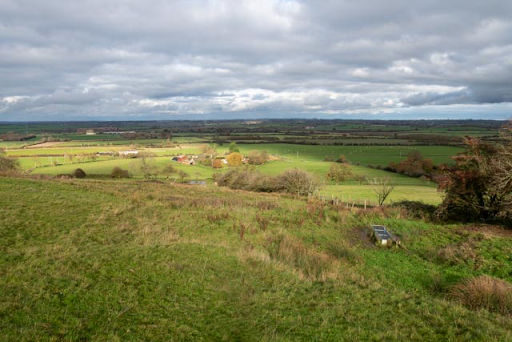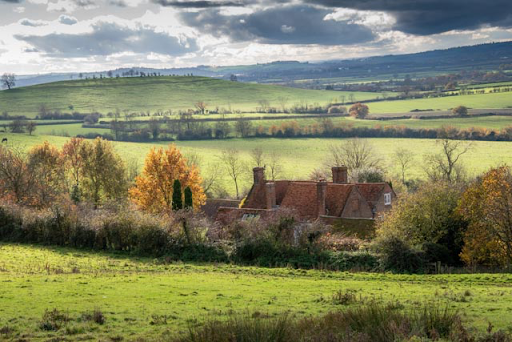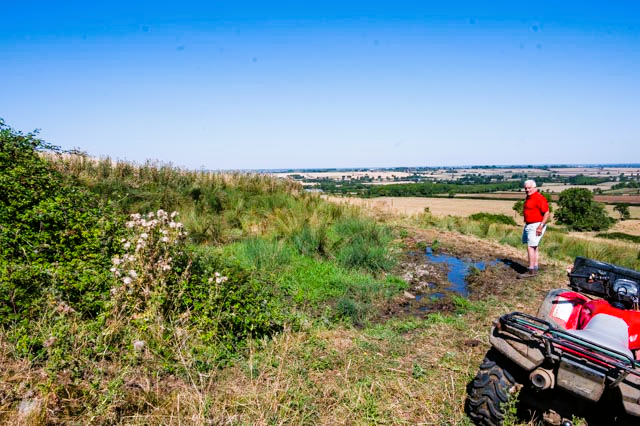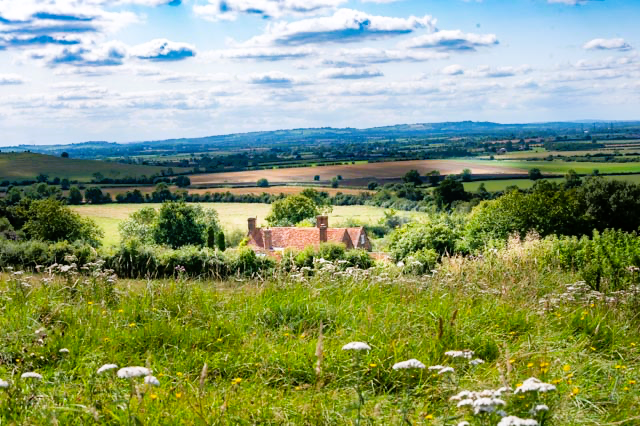Tom Morrison, Hogshaw Hill Farm 1/3
Tell us about your farm, its location, size, altitude, climate, soils, enterprises, organic/PfL/other status
Three things make biodiversity at Hogshaw Hill Farm special; geology, hydrology and hedgerows, along with the way we farm, which is underpinned by the Pasture-for-Life approach.
Almost everything on the farm and the way it is managed is derived from the geology and hydrology of the area. The farm is in north Buckinghamshire between Buckingham and Aylesbury on a spur of the Chilterns that looks down on the clay vales. A central feature is a greensand hill, once a bronze-age fort, 370 feet above sea level at the top, offering views into six counties.


It is on the watershed divide between the Great Ouse to the north-east (top photo above) and the Thames to the south-west (second above photo). Half-way down the hill the sand meets heavy blue clay, and several springs emerge, right across the farm. Obvious, you might say, but it’s not as simple as that. Entomologists have recently discovered a small marshland beetle, Limnichus pygmaeus (a first for Bucks) living around the springs which indicates that they haven’t dried since the ice last receded from the land at the end of the last ice age. In other words, they’re artesian, and the spring water isn’t only from the local catchment. Strong flow continued during the long 2022 drought (first photo below).


Besides the sand (Lower Greensand to a geologist) and clay (Kimmeridge montmorillonite – very heavy blue stuff) are limestone (also linked to Dorset’s Kimmeridge and containing spectacular ammonites and other fossils) and ironstone, each of which supports its own flora and fauna.
The farm is all-grass, mostly ancient species-rich pasture, 68 ha (168 ac) all in Mid-tier Countryside Stewardship. Also fairly ancient is the farm manager – me – and I have deliberately designed what I call my geriatric farm system, one that suits me. It comprises, besides me, a quadbike, a bull, 30 cows, and all the followers through to finishing just before 30 months. A contractor makes hay on the low clay land in the summer, and I feed it from a quadbike trailer on the high sandy land in the winter. What could be simpler? It suits me but it also suits the cattle and especially it suits biodiversity. Anything that could be left to Mother Nature, I tend to. I’ve learned to stand back to give Her room, and I intervene only when I’m sure it’s necessary; or when that intervention serves to strengthen a natural process or improve biodiversity.


Share with us a general description of the biodiversity on your farm – essentially above ground (but reference to below ground if relevant) – both flora and fauna.
There is little uniformity at Hogshaw Hill Farm in terms of slope (very steep to flat), aspect (all points of the compass), soil type (pure sand to pure clay), or drainage (bog to arid); so the biodiversity is naturally highly variable. Man has influenced this natural variability only slightly through turfing some of the flat land (50 years ago), ploughing (most recently 25 years ago, during WW2, and in the medieval period), planting hedges (mostly during the Enclosures), and woodland and wildlife corridors (during the last 30 years). Perhaps the greatest damage to this natural biodiversity has been through nitrogen fertiliser on the hay fields during the last decade, but that has now stopped.
Species lists have been made during the specialised surveys mentioned in section 6 below. We can briefly mention just a few species to illustrate the breadth and depth of biodiversity at HHF. They include: yarrow, common bent, meadow foxtail, barren brome, soft brome, creeping thistle, Yorkshire fog, autumn hawkbit, timothy, knotgrass, rough meadow grass, sorrel, dandelion, ladies’ bedstraw, white and red clover, black medick, bird’s foot trefoil, common and kidney vetches in the pastures; bullace, an ancient white plum, in the hedgerows; dragonflies and damselflies on the ponds; Orange Tip butterflies where their food plant Lady’s Smock grows, and various sedges in damp and boggy places.
We have barn, little and tawny owls. Lapwings sometimes visit in the winter. Curlews were common here 50 years but are now rarely seen; we’re trying to lure them back with new scrapes and ponds to add to the quite high density of ponds in the immediate vicinity of the farm. Snipe are common here but don’t breed. Yellowhammers linnets and goldfinches are all present. Among the warblers, whitethroat, blackcap and chiffchaff all breed in numbers. Swallows breed in numbers in the barns, and feed over the insect rich pasture.
Larks and meadow pipits are especially abundant, feeding on the invertebrates that are encouraged by the way we feed winter hay, see section 3 below.
In autumn this outlying spur of the Chilterns attracts large numbers of southward moving migrants. Wheatears are common, and whinchats and redstarts have been recorded on numerous occasions. In particular in September a huge congregation of thousands of meadow pipits is often present on the hill, which attracts a variety of birds of prey.
Diurnal birds of prey present throughout the year include buzzards, red kites, sparrowhawks, kestrels, and in the summer, hobbies.
A recent reptile and amphibian survey by BBOWT revealed all expected species: frogs, toads, great crested and common newts, and grass snakes.
Bats are common, as one would expect with year-round dung beetles to feed on, and water surfaces over which to hunt. The rare red-listed Bechstein’s bat has been identified about two miles from the farm and might be here too.



